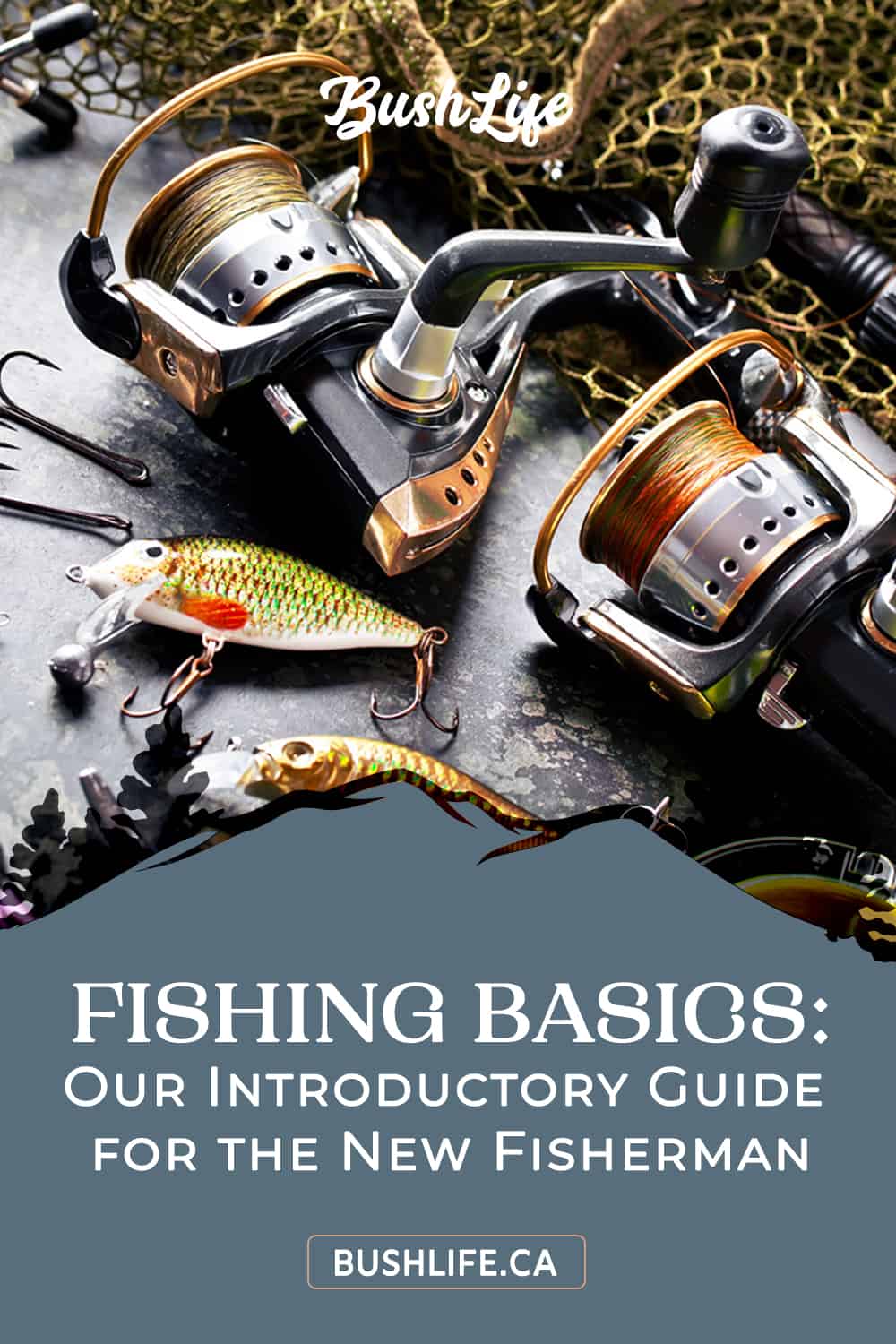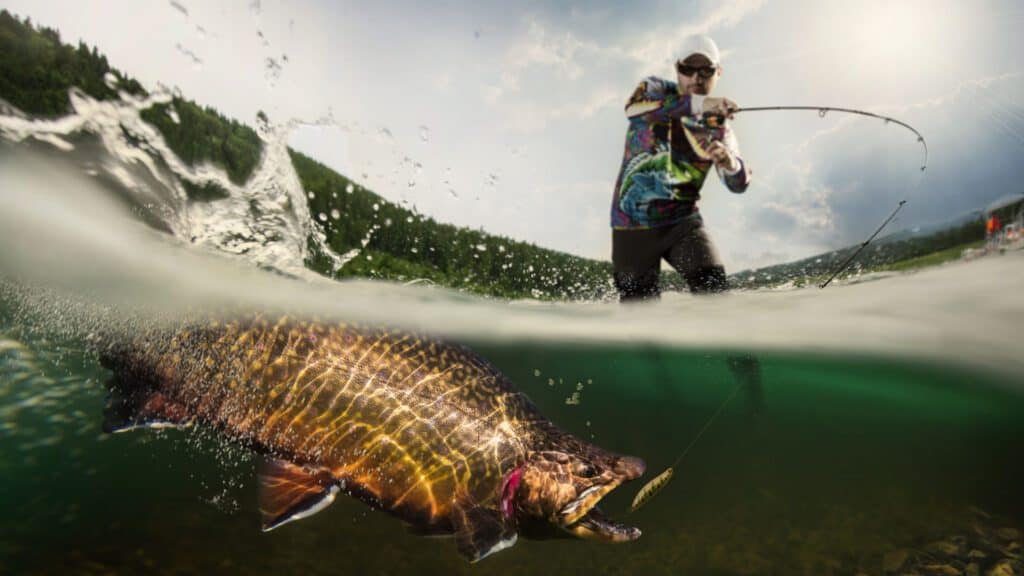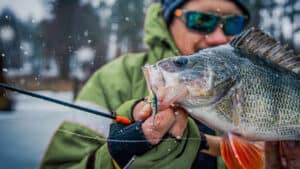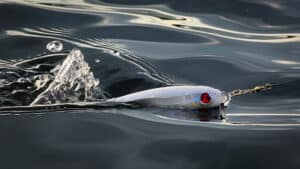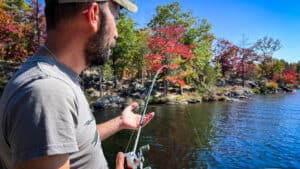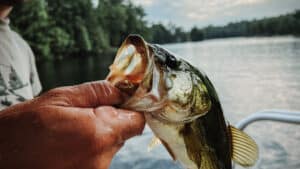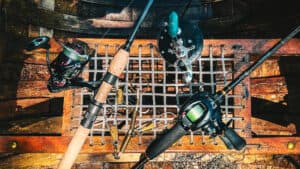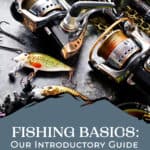Today’s post is an introduction to fishing for beginners or Fishing 101. We’ll cover everything from licensing to fishing equipment to catching your first fish. This post is perfect for someone who has never fished or requires a refresher.
The objective is to give you enough knowledge to get you out there with all the fishing gear and skills you’ll need to start fishing today! It’s not a strenuous hobby to get into. For the little more seasoned angler, there are several helpful tips here.
Discloure: Posts may contain affiliate links. Purchases made through our links result in a small commission to us at no charge to you. We only recommend products that meet our brand standards based on testing and first hand use by our authors.
My Fishing Journey
My grandfather, who taught me everything he knew, was how my fishing journey came to be. We enjoyed decades of fishing together, and it became a bonding experience like no other. I also can’t think of a better way to enjoy a lake or river. Since those little boy years, I’ve caught thousands of fish and have been at it for almost 40 years. Hopefully, I can pass down Grandpa’s age-old techniques to you as I have to others. So stay with me as we work through these sections.

Yes, that’s me in the photo after a few hours of fishing. Yes, again, it was a good day! But skills create more good days than luck, so let’s get started and look at a few fishing basics.
Do I Need a Fishing License?
The following regulations are for Ontario, Canada. If you reside elsewhere, your province or state will have similar rules.
Skip this section if you already know the licensing or are out of province.
Fishing for beginners in Ontario requires you to hold a fishing license. There are exemptions for those under 18 or 65 and over. There are also some exceptions for armed forces members, veterans and members of specific indigenous communities.
Unlike hunting, there are no course or knowledge requirements. It’s just a matter of providing your information and payment. For more information on licensing in Ontario, you can visit the Fishing License page of the Ontario website.
Just because there are no knowledge requirements for your fishing license, there are, however, several laws and rules that must be strictly adhered to. These laws include how many fish you can keep, what size they need to be, what the open seasons for fishing are and so on. Of course, this is all based on the specific water body you are fishing and the fish species. The fishing laws are on a different section of that same Ontario website. It’s a short and easy read.
Purchasing Your Fishing License in Ontario
When purchasing your license, you’ll find there are two components. The first is your Outdoors Card, which is valid for three years. The Outdoors Card is plastic, no different than a Health Card or Drivers License. The cost is under $10 and is the cheaper part of the deal:) It’s simply your ID to which your fishing or hunting license information is attached.
Once you have your Outdoors Card, you can add your fishing or hunting licenses. For a fishing license, you can purchase them for one year or three.
Where to Buy My Fishing License in Ontario
The Outdoors Card and fishing license can be bought in person at many tackle or outdoor stores in addition to Service Ontario outlets.
You can also purchase your license online at Hunt and Fish Ontario. And manage your account or purchase additional licenses, such as hunting. If you are wondering how to get started in hunting, we can help you get started here.
Sport Fishing vs Conservation Fishing License
The fishing license comes in 2 versions: sport and conservation. For example, on my lake, the catch limit for bass with a sport fishing license is 6. For a conservation fishing license, it’s 2. The difference between licenses is simply limits and price. I suggest a sports license if you are new and uncertain about how many fish you intend to keep.
Ontario Fishing Regulations Summary
Every year, the MNR (Ministry of Natural Resources) determines the size, catch limits, open season dates, etc. We know them as the MNR, but technically, they are now known as the Ministry of Northern Development, Mines, Natural Resources and Forestry. Their fishing regulations and limits hinge on the research they conduct. Through this research, it helps prevent overfishing, and it’s there to protect healthy fish populations and conserve natural resources for future generations.
The Ontario Fishing Regulations Summary is always issued free of charge in booklet form. You’ll find it in outdoor stores like Sail or any tackle shops. It is also available here for download in pdf.
At first, sorting out all the regs may seem daunting, but it’s not. Unlike more complicated hunting, fishing is somewhat straightforward. You will need a copy of this booklet. Make a mental note that it does change annually.
Make sure you carry your license when fishing. I highly suggest you read the pertinent sections of the regulations for the water body you want to fish before you go fishing! The fines and penalties for not following the rules are severe.
Free Family Fishing Opportunities for Beginners
There are four occasions when Ontario and Canadian residents can fish without a license. At the time of writing (2022), here are the dates:
- Family Fishing Weekend (Feb 19-21)
- Mother’s Day Weekend (May 7-8)
- Father’s Day Weekend (June 18-19)
- Ontario Family Fishing Week (July 2-10)
You must have a government ID and follow conservation fishing limits. More importantly, I bring this all up as it’s a perfect opportunity for someone on the fence to try fishing free of charge and see if it’s for them. This opportunity DOES NOT happen in the hunting world.
Types of Fish
I am in the Kawarthas myself. In this area, you can find the following fish species: Sunfish, Perch, Crappie, Bass, Walleye (Pickerel) and Muskie.
For this post, I’ll elaborate on these fish types, and we will cover some other varieties in later posts. It’s imperative to learn the various types of fish species as you’ll need to know how to identify them, how to fish and what lures to use. Let’s consider learning this step 1 after getting your license.
Sunfish
Let’s throw the Bluegill fish species into this category and chalk them up as the little guys we don’t target. There is a small group of people who like fishing for sunfish. I don’t understand why, as they are too little to put up any fight, so the sports aspect is out. They also don’t have a lot of meat and are not worth keeping. You will inadvertently catch them and probably do what I do and gently put them back in.
As an FYI, children love fishing sunfish, as they are easy and fun to catch. We’ll cover that towards the end.
Perch
If you fish Lake Erie, you can get some pretty big Perch! In your typical inland lakes, you’ll get small ones. That being said, it’s not something I target as I go for bass and walleye, but I do catch the odd Perch. If the Perch is big enough, I’ll keep it as they are super tasty!
Crappie
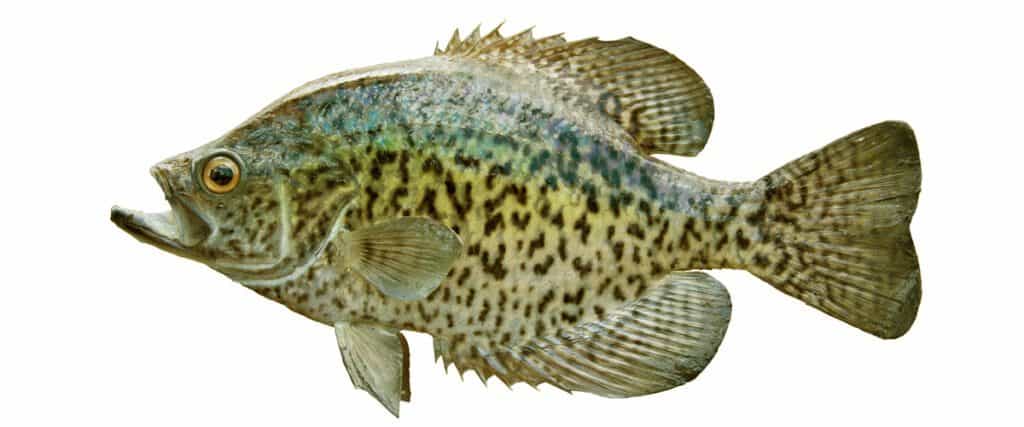
Crappies are interesting, even the name, as I can’t imagine who came up with that. This fish species is flat – imagine a giant sunfish but dark in colour. When hooked up, they fight hard and give you the impression you caught something big! The fight does die off fairly quickly and is a good indicator you have a crappie.
I’ve fished my lake for two decades without ever knowing they exist. Now crappies are very abundant. The upside with crappies is that they taste great, and I find them to be very easy to fillet. On my lake, the season for crappie is open all year, and the catch limit is substantial at 30 for a sports fishing license.
Bass

Bass are a fun fish to catch. When you hook up, you generally know it’s a bass as they fight well. They tend to come up to the surface and jump out of the water. Many anglers target bass as it’s an easy species to catch.
I can’t say I notice a massive difference in taste, or should I say I’m no connoisseur. But a bass is bass and nothing special. The odd time cleaning them, you’ll find worms in their bellies, which can turn some people off.
Walleye
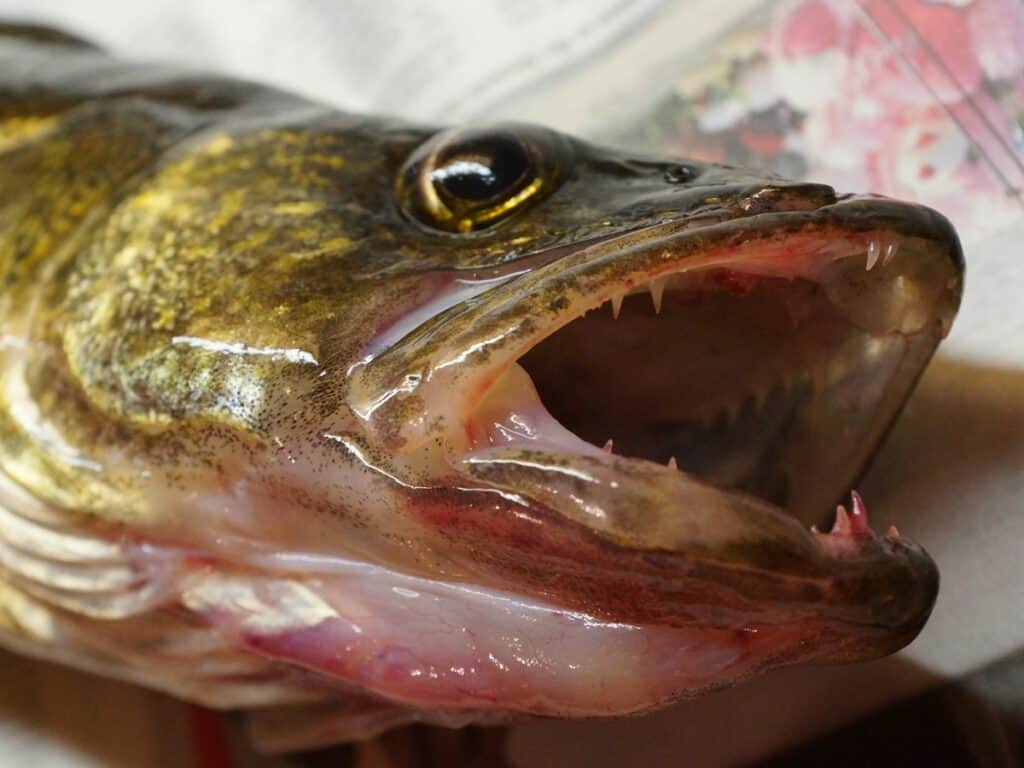
Walleye is the most coveted of all fish species around Ontario and native to Canada. It’s an excellent-tasting fish and targeted by many an angler. But it’s a lot harder to catch and always has been. I have techniques that work great on walleye, but I will admit that they are becoming more scarce.
To compare walleye to crappie, the limit (number of fish you can keep) for walleye on my lake is 4. It used to be 6. There is also a limited open season that runs from sometime in May to November.
I’ve always known walleye as a pickerel. Supposedly, the American nomenclature is walleye. You will, however, find pickerel listed as walleye in the Ontario regulations. The terms have been used interchangeably around here and are probably the source of many fireside debates. I can’t tell you what’s right or wrong, but my point is if you speak to someone about pickerel or walleye, you are talking about the same thing:)
Muskellenge, Muskie or Musky
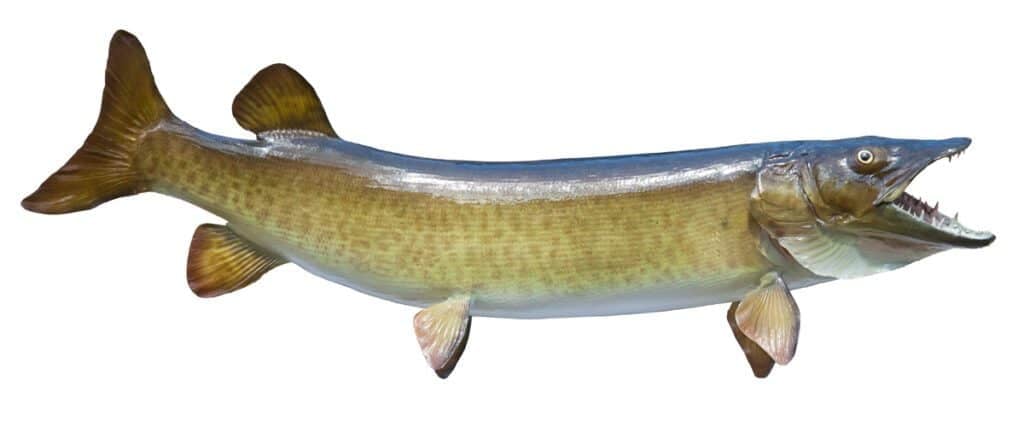
Muskies are like the sharks of freshwater. We are talking about a 24″ – 48″ fish with big and sharp teeth. To paint a picture, I don’t keep my catch in the boat’s livewell. Instead, I chain them and hang them beside the boat in the water. Over the years, I’ve lost a few bass and walleye to muskies going after the “low-hanging fruit” of a captive fish. More importantly, the muskie is capable of attacking a fish this size.
While I haven’t seen it myself, the story goes that many ladies have been bitten on their toes thanks to some shiny red nail polish. These guys are predators.
The muskie stinks and is often a good indicator that one is in the area. That smell almost always correlates to a lapse in bites on your fishing lure – probably because other fish have fled the area. The muskie is not a typical fish you target for food. However, it is a trophy fish you catch for fun or to mount on the wall. You then post the photo on Facebook and brag about it for 30 years. That is if you can catch one:)
Muskies are rare and more difficult to catch than all the other listed fish species. Once you have mastered fishing, it is then that you can target reeling in a muskie.
The last item to mention here is it seems like when a water body has muskie, it doesn’t have pike. The opposite is true for water bodies with pike. The pike is also a common fish in Canada and a part of the same family as the muskie.
Further Reading: A Promising Pike Fishing Rod = More Fish in the Boat
Eating Muskie
Let’s take a minute and elaborate on the muskie for food. I always knew it as a not-to-eat species and assumed it was based on smell or taste. It wasn’t until later in life that I learned from several people who eat them, that the taste isn’t bad at all.
I prefer to take a quick picture and put them back in. It’s almost a sacred right of passage to catch one, and giving it back to the fish gods couldn’t hurt either.
As an FYI, the muskie carries higher levels of mercury, and its consumption is non-advised for children, nursing mothers, or people who want to have children.
If anything, I wouldn’t “target” it specifically for food, as you may end up starving to death:) No pun intended.
The Benefits of Eating Wild Fish
Since we are mentioning taste as we cover the fish types, let’s consider what kind of meat fishing provides:
- Fresh
- Wild / Free Range
- Organic
- Antibiotic Free
- Hormone Free
- Gluten-Free
- insert trendy catchphrase here!
I want to mention this quickly before we continue, as these benefits don’t occur to most people. Nothing is more fresh and tasty than a just caught and cooked fillet, pan-fried in butter. If you haven’t experienced that, the reward is beyond exceptional, and you are in for a treat!
Can You Catch and Release Fish?
Unlike hunting, where you can’t recall that bullet or arrow, fishing does tick off one extra box. Catch and release is a very viable and sustainable fishing option. In other words, if you are looking for something fun to do outdoors but don’t want to be a part of the ecosystem, or maybe the thought of filleting is not for you, you can safely and sustainably release any fish you catch unless you reel in a few of the invasive species that are not permitted back in.
Fishing Equipment for Beginners
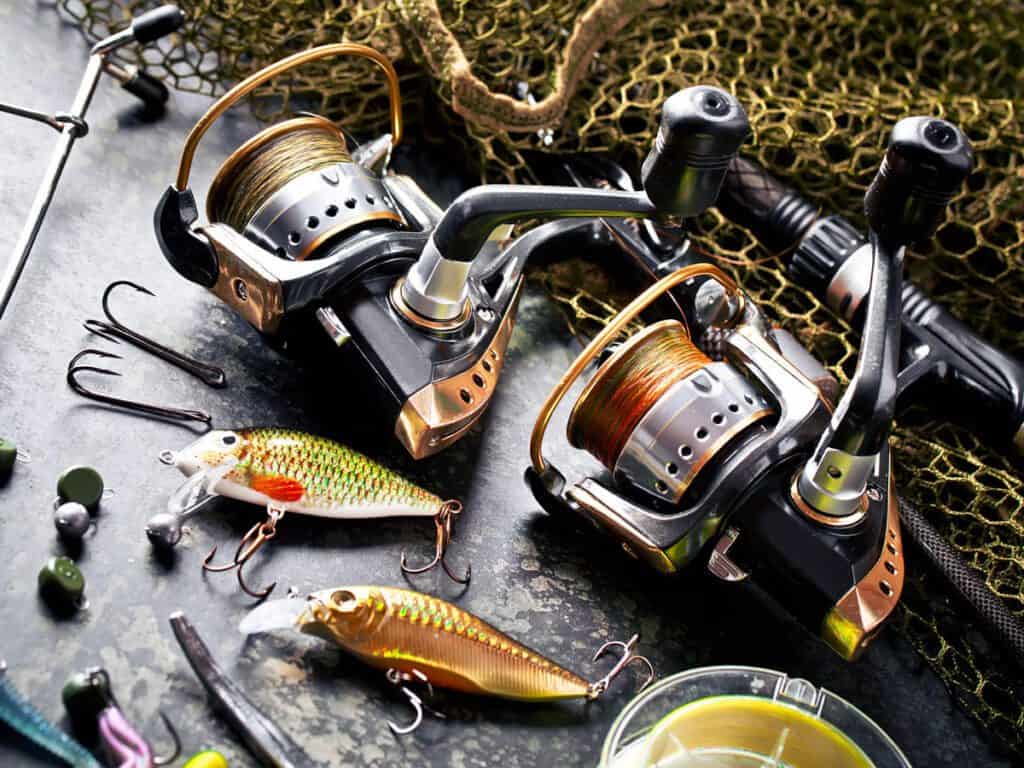
For you to start fishing, a basic set of fishing equipment is required, and other fishing gear are wish list items. Let’s look at what you need, how to choose it and why.
Fishing Rods for Beginners
The most vital fishing gear for beginners is the fishing rod and fishing reel, which I’ll cover in greater detail. You’ll need a good fishing rod and reel combination. The rod and reel should feel good to handle and use and be suited to your style of fishing.
Let’s start with length. A fishing rod around the 6 to 8-foot mark is the sweet spot. A fishing rod that is too long is too cumbersome to deal with. A rod too short, and you’ll lose feel and reach.
I checked my favourite fishing rod for comparison as I honestly don’t know its specs off hand. It comes in at 6’6″. In fact, I just realized all my rods are 6’6″. The sections below will elaborate on other big details.
The Fishing Rod’s Action
Next comes stiffness. The action of a fishing rod is the speed with which it returns to a normal straight shape. It also affects how much the rod bends when applying force to the tip. Faster action = faster return to straight position, bending is closer to tip = stiffer rod. Slow-action fishing rods will bend almost all the way. Rods generally come in a slow, medium, fast and extra fast action.
A softer (slow action) fishing rod will cast farther and handle certain baits better. However, it’s best suited for smaller fish species. Fast-action fishing rods are much stiffer. The advantage to this type of rod is using it when you need a quick response in your fishing lure. For example, when setting the hook. In basic form, the faster the action, the more suited the rod is for larger fish.
My favourite rod also has a fast action! That suits bass, walleye, and so on, which is my main target and probably yours too. It’s also the best of both worlds as a happy medium between slow and extra-fast action. If you haven’t guessed it, I would also say it’s the best place to start for your first fishing rod.
What Fishing Rod Action Do I Need for Trolling?
If you like trolling (covered further below), you’ll want a bit of a stiffer rod. Even within the action classes, there can be quite a difference in stiffness.
You can check the stiffness by holding the fishing rod and standing 90 degrees beside a wall. From the side, push the tip (even the last 6″ of the rod) against the wall sideways. You can even bounce it a little against the wall (without letting the tip leave the wall). It’s the best way for you to “feel” how much bend you have in general.
I do apologize as I won’t be able to explain what’s correct when doing the above test. Even a video won’t convey a feel. It’s an advanced technique you’ll learn with experience and over time. However, you’ll notice a difference when comparing two fishing rods using this method.
Fishing Rod Power
If action isn’t enough, fishing rods are also measured by power. Power plays a significant role, ranging from ultra-light to extra-heavy – yet another range to contend with.
All my fishing rods, at least the ones where the writing is still legible, are medium. In a nutshell, power is about how much force is required to bend the rod. More power = is suited for larger fish.
Naturally, power will also affect stiffness. Between the action and power, we now have two variables to control: how much bend we allow and where the rod bends.
The Spinning Fishing Rod
When deciding what fishing rod to buy, the two dominant ones are bait casting and spinning rods. Sadly, the naming conventions are confusing, as “spinning” rods are meant for casting as well.
Typically, you use a spinning rod for lighter fishing lures. The spinning rod is a great all-around fishing rod and is the most popular and effortless. They are also not as advanced as bait casting rods. Hence, this is why it is better suited for fishing for beginners.
Fishing Rod and Reel Brands
Be warned, there are many fantastic brands, and they are so shiny my wallet goes into hiding as soon as I enter a tackle shop! Frankly, it’s confusing and can be hard to choose the perfect rod. So, I’ll share with you what I use just in case you are looking for a starting point.
I use Shimano more than anything as it’s fantastic value for the money. Shimano has no affiliation with our blog. Their products are of exceptional quality and last a long time. Honestly, it doesn’t matter to me what you choose, but if you are lost amongst the sea of big brands, Shimano is a great starting point. Daiwa also has a few budget-friendly fishing rods worth looking at.
On my thirteenth birthday, and bless my grandparents’ hearts for what they did, it was time for me to graduate to an adult rod and reel of decent quality. So they bought me a Shimano fishing rod and reel. I used and caught thousands of fish with it for the next 25 years. To this day there’s nothing wrong with it, but I retired it as I couldn’t bear losing it. Cost: Around $100 if I remember correctly, but that was in 1992.
Fishing Reels for Beginners
I suggest starting with an open (not push button) spinning reel.
One of the significant considerations in fishing reels is gear ratio, Ie. A reel with a ratio of 5.2:1 turns the spool 5.2 times every time you crank the handle one time. The higher the ratio, the faster you can reel the line in. However, it makes it physically harder to reel in heavy fish as the ratio gets higher. Most spinning reels are between 5.2:1 and 6.2:1, and either way is not a deal breaker.
Bearings
The other main difference is in quality and number of bearings a fishing reel has. The number of bearings determines how “smooth” a reel will be. Quality reels are made with ball bearings, and you’ll often see “ball bearing” written right on it somewhere with a number proudly stating how many.
Spool
Spool capacity is one other thing to watch for. You don’t want a spool that is too shallow as it holds too little line. It will affect casting, how much line you can let out and limit your fighting ability if you hook a big one and choose to tire the fish out. Too much line and it costs a lot to fill and replace periodically. My favourite spinning reel holds 100 yards of 10 lb line and is a happy balance for the fish types we covered above – other than muskie.
The Shimano Sienna fishing reel is a budget, entry-level reel for Shimano, and it will get you out there. Moving up in price is something like the Daiwa Fuego – which we own ourselves and can attest is an outstanding reel for the money.
As you climb the ladder, you get more options when ordering (affects price), but you can tailor the fishing reel a bit more to your needs.
I won’t link anything else, as fishing reels go up in price and can cost hundreds of dollars. Other than for avid anglers who know what they want, I don’t see the point of looking at it now.
Further Reading: How to Choose the Right Fishing Reel: A Comprehensive Guide
Final Words on Fishing Rods and Reels
Up until recently, all my fishing rods were spinning rods. Most of my fishing rods were relatively old, and rods are so personal that I can’t suggest a specific one for you. My go-to rod at the time was another Shimano (approx $100 spinning rod and reel combo) bought 12 years ago. 6’6″ long, 6-14 lb line weight, 1/8 – 5/8 oz lure weight, medium power, and fast action. Anything of similar specs will cover the fish types listed above except for the coveted muskie.
My advice is to borrow some fishing rods if you can and see what you prefer. Then run out and spend around the $200 mark or up for a fishing rod and reel that is perfect for you. You’ll be happy with the outcome.
What is the Best Fishing Line?
Now that we covered the fishing rod and reel – let’s look at the type of fishing line you need to start your fishing journey. Back in the day, there was only monofilament. Today, that’s the cheap stuff, well, sort of. The big problem with mono is that it dries out over time and will break. While all fishing lines need replacement eventually, mono is only good for a year, whereas braid can often handle multiple seasons.
A simple test to see if a fishing line is still good: tie a basic knot (with room on both ends so you can grab a decent section) and pull hard to see if it breaks. Do this before buying a new monofilament line in-store! You’ll be shocked at how many fail even when “new” in the package. With mono lines, it’s also a spring chore to double-check and replace all your lines.
“Newer” to the market is the braided fishing line. It’s a lot more money, but it hardly ever breaks. It also lasts for years – at least mine does. More importantly, I have not lost fish to broken fishing lines since switching to a braided line.
When I said mono is cheap and braid is more expensive, once you factor in the longevity of the braided fishing line, it becomes a debate about what is more cost-effective to run. Of all things, DO NOT skimp on the fishing line, as you will regret it when you lose fish after fish!
Braided Fishing Line
Suffix has made a notable name for itself, and their 832 line in a braid is what I use. As a rule of thumb, I would suggest a 20-pound fishing line for basic bass or walleye fishing. Speaking of which, the main feature of the line is weight. The weight of the pull is the first thing to look for when comparing lines. A 10 lb line means it will hold 10 lbs without breaking.
I’ve always used a 12 – 20 lb fishing line. If looking at braided, it will spec a monofilament equivalent. In the fishing line suggested above, its properties (thickness) are similar to that of 8 lb mono, but its strength is actually 20 lb. One of the significant factors as to why braided is so popular.
Bigger isn’t always better, so don’t go overboard on line weight. Heavier line won’t cast as far, nor will the reel’s spool hold as much line.
How to Tie Fishing Knots for Beginners
Since we’re talking about fishing lines, a quick note – a fishing line knot guide is sometimes enclosed or written on the package. If not, there’s a phenomenal iPhone app called Knots 3D. For Android folks, you’re in luck as well. This app covers all knots, including fishing! The tutorial is in a video format. Hence, the app allows you to slow down the tutorial for effortless learning.
If you don’t have a cell phone, no problem! Here’s a YouTube video on the Trilene knot from the channel, with credit to FTWQ. This knot is what I’ve used for almost 40 years!
An FYI to the video – when he says it’s time to “lubricate” the knot right before cinching, he probably licked it or put it in his mouth to moisten it. And he’s right – doing so prevents the line from cutting itself. It also helps seat the knot. Do not omit this step, but don’t worry, it doesn’t taste bad:)
The best news of the day is you only need to know one knot to go fishing! So don’t lose any sleep over all the infamously tricky fishing knots:)
Fishing Accessories for Beginners
You’ll want some snaps. Snaps go on the end of the fishing line, so you can change fishing lures without re-tying every time. Here, you’ll find an economical swivel snap pack from Amazon. Your line ties to the round swivel, and your lure is attached using the clasp on the opposite end.
You will also need some weights, which are lead to help sink particular lures. I prefer the inline type that goes on before the swivel. Granted, I don’t change lures often. Some people may prefer the clip-on weights for ease of adding and removal.
What are the Main Types of Fishing Lures?
Many anglers fish with a simple hook and worm or hook and minnow, called bait fishing. Personally, live bait is not for me – it’s a PITA. And, it’s a chore to fetch and store live bait, especially with Ontario’s new live bait regulations.
Worms attract the sunfish, and I’m not so charitable in my spare time as to feed little fish all day. Admittedly, I’ll use minnows in the fall when walleye go deep looking for warmer water, and that’s about it.
Further Reading: Choosing the Best Bass Fishing Lures: A Beginner’s Guide
What is an Alternative to Live Bait?
A good fishing tackle kit will have a variety of the following man-made lures, such as:
- Jerkbaits and crankbaits (generally fake minnows), either jointed or straight, including surface & diving plugs
- Jigs (hook and weight combo), which is used with all kinds of plastics or live bait
- Spoons, which are shiny metal spoon shapes and a hook
- Spinners (anything with a spinner)
Truthfully, most of what I’ve caught comes from a homemade rubber worm rig with beads and a spinner. So, I suppose it properly falls in the spinner category. I’ll write an entire post on how to make it one of these days. This rig has served me well for almost 40 years! And I’ve caught everything on the types of fish list above with it, even a muskie. Here it is:
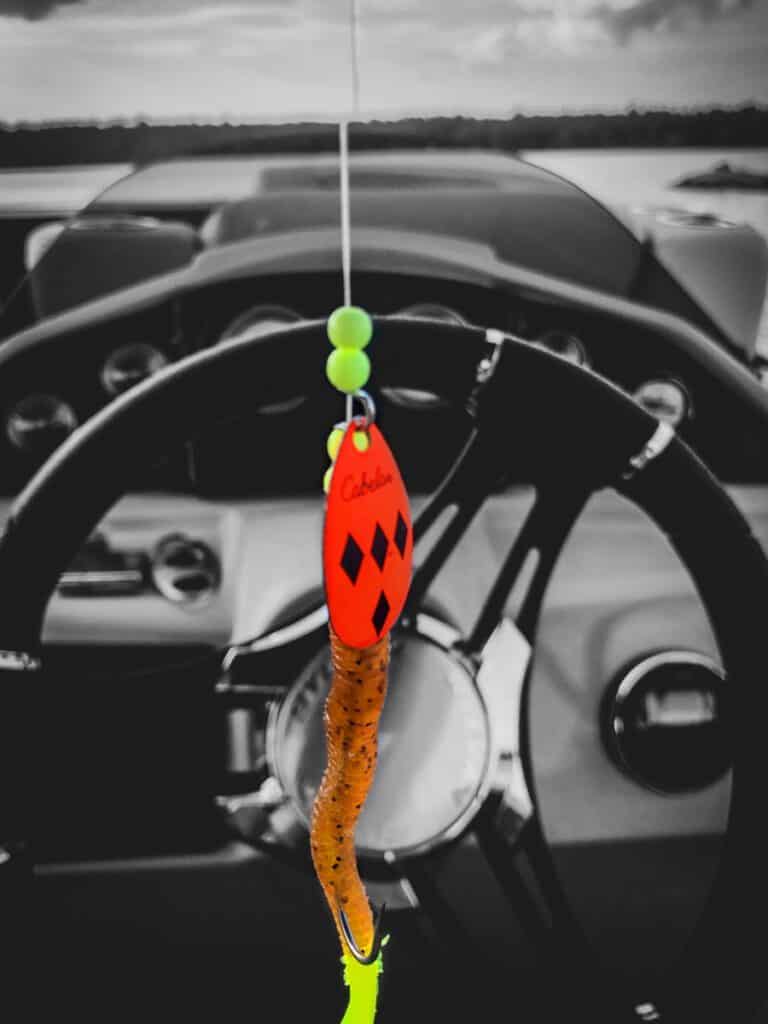
A Basic Set of Fishing Lures, On A Budget
The Topconcpt 275-piece Kit is NOT for an established angler, so please don’t buy it as a gift for one. The seasoned fisherman already has a substantial assortment of lures, including their favourites. What this kit does is, at around $40, introduce a beginner angler to an assortment of different lures without much financial risk.
We all start with something like this, but it is one item I can’t speak to as I don’t own it myself – and can’t refer to it wholeheartedly. My point here is quality lures range from $5 to $30 a piece, and you need enough variety to test the waters and see what works for you.
Your other option is to scour the used market like Kijiji or Facebook Marketplace. Your challenge here will be establishing if the value is correct. Hopefully, you have a friend who likes to fish, and you can run it by them for advice.
My final point here is if money is tight, but you are dying to go fishing, focus your budget on your fishing rod and reel. It’s easier to add lures later and build a set as you go and over time.
Getting Some Better Fishing Lures
You’ll eventually want brands like Megabass, Teckel, 6th Sense, Rapala, Rebel, Berkeley, Heddon, Mepps, etc. If you’ve confirmed fishing is for you and budget permitting, by all means, stop by a tackle shop and get a few of each of the fishing lures on my list above from the better brands.
Better yet, ask behind the counter, and they’ll be more than happy to help put together a basic set, perhaps even tailored to your area. If they’re not, go to a different store, as they don’t deserve your business.
Either route you take, I suggest getting a few of each type of fishing lure in varied colours and sizes. Just get out there and start throwing them to see how they work and what you prefer. Each water body, region, type of fish species, time of year and so on is different. Only time will tell which lures work best for you.
Further Reading: 11 of The Latest Spring Fishing Lures for 2024
A Basic Tackle Box for Beginners
You’ll need something to store your line, weights, swivels, hooks, lures, pliers, etc. This is where the tackle box comes in. A good tackle box will have an assortment of compartments – correctly sized to organize your tackle.
I’ve had two iterations of tackle boxes over the years. The Flambeau Double Satchel is perfect for someone with very little tackle. I use one myself. If casting offshore or moving around, it’s a lot less to carry, yet big enough to give you everything you need for a basic set. When on shore, especially in tight areas, it doesn’t take up a lot of space.
With compartments on both sides of the tackle satchel and with simple access, it gives you quick access to your most used items. Mine is always full and ready to go wherever I go.
The Main Tackle Box
For a more extensive fishing accessory set, I use a larger box and prefer the Plano Guide Series. These are soft-sided and have ample pockets for gear with organizer trays for fishing lures. I keep my lures organized by type in the trays (topwater, jigs, cranks, etc.). This way, when pulling a tray, all my similar lures are together, which makes it easier and quicker to choose which one to go for.
I generally keep the Plano Tackle Bag in my boat, so I don’t have to grab it when heading out. I understand that some people may not have that luxury. However, one can pop in a phone or other personal items needed in these compartments, leaving you with one bag to carry.
I can tell you after years of use, I have no issue with my tackle bag and love it as much as the day I got it. It is a big step up from the old school, chunky, plastic flip-up lid-style boxes. God forbid if you ever flip the old school ones over, it becomes a mess and a half. The Plano Guide Series is a winner in my mind.
Fishing Pliers – Very Important
Make sure you get yourself a pair of long-nose fishing pliers. You’ll need this for when the fish swallows the hook too far. And trust me, it happens. Without the pliers, you’ll be reaching into a fish’s mouth (often with teeth), or you won’t be able to get in far enough by hand. That means cutting your line, re-tieing, wasting time and losing your lure.
Fish Stringer – Very Important
I did mention earlier that I use a chain and not the boat’s livewell. By chain, I mean a “fish stringer”. When keeping your catch, you want to keep your fish alive until you come in. Doing so prevents rot and poses a minor challenge with handling your keep.
Firstly, a livewell is only available on a boat as a built-in. And most boats don’t have them. Yes, it keeps the fish alive. But when you dock, you’ll need to drain it, catch your flopping fish, transfer your fish to a container, wash your hands and sometimes even wash the well to avoid the smell.
Then you bring your fish home and clean your container – by container, usually a bucket. This process is a nuisance.
As to the fish stringer, it is tied to the boat or something on shore. All you need to do is keep the fish in the water to keep them alive. Remember to pull the stringer from the water before gunning it for home.
The Rapala Metal Stringer is quality and one area I highly advise you not to skimp. The $14.99 stringers are low-quality metal and will get rusty, which leaves a mess of anything you leave it on. Or your hands.
Fishing Net
Last but not least, in the fishing gear department is a net. You do not need a fishing net unless you are going after trophy-sized fish or are not used to handling fish and are nervous to do so. It’s something you can deal with later.
A word to the wise – the day you buy a net, get a tangle-free one. Some fishing nets have a thick coating on the mesh to prevent tangle. Either way, and I’ll say this out of experience, don’t waste your time with a basic mesh net – it will tangle with your lures (and fish), over and over again.
Techniques for Fishing for Beginners
Let’s cover the basic techniques or methods of fishing, and I think you are ready to go!
Bait Fishing
The oldest method of fishing. In its basic form, live bait goes on a hook and down towards the bottom of the water. You pull it back a given amount, so it’s not sitting on the bottom. Then place your rod down and watch the tip for movement.
Using this method, you can set the depth to anything you want.
Floating bobbers aid in casting this type of rig out and then watching the bobber go under versus watching the tip of your rod. This method helps when fishing from shore to get your bait farther out and into deeper water.
Casting
Casting is for casting fishing lures. You can cast and pull in evenly, such as pulling in a rubber worm rig. You can bounce a weighted lure across the bottom.
Big surface plugs are fun – use a jerk-and-reel action – jerk the rod, watch the plug dive, reel in the slack and repeat with pauses in between. That’s the muskie method my grandfather taught me.
A similar concept is “Walking the Dog”. Scott Martin, a YouTuber, demonstrates this method nicely. Using this method with a good fishing lure can drive bass crazy. Not to mention, topwater fishing opens up shallower areas for fishing.
Trolling
I have my favourite spots that I like to troll. I spent 95% of my time fishing using the trolling method. To troll, cast in and drive your boat around very slowly. Generally, I do big circles in my favourite locations, and others are a straight run, which you then turn around and troll back.
This method is not only fun as the scenery changes, but it works and has served me well all these years. I’ve caught countless bass and walleye trolling with my simple rubber worm rig, and it boggles peoples’ minds when I come in with a full stringer consistently.
By trolling, your lure spends MORE time in the water. That means MORE chances of catching something. You are moving around constantly, which also helps your odds of finding fish.
The big key with trolling is to go slow. Most people use a little electric trolling motor on their boats to achieve their desired speed. I’m used to sitting behind the wheel and idling my boat motor. It’s far more comfortable! But most boats still go too fast at idle to troll.
I don’t remember who discovered this around 30 years ago, but it was like hitting the lottery. My family has had the Happy Troller Trolling Plate on four boats over the last 30 years. I’ve also had countless friends fall in love with it. To use a trolling plate, you simply pull the cord at your destination and the plate drops. It brings your boat to that tantalizing perfect speed for trolling!
Trolling for Walleye
Remember, most people are trolling too fast!
The bonus when targeting and trolling for walleye: You will pick up a lot of bass, crappie and everything else along the way.
Where to Go Fishing for Beginners?
I don’t know, ask around! All kidding aside, you need to learn the waters and understand the behaviours and habitats of the fish species you intend to fish. Over time, as your fishing skills develop, you’ll even understand why.
Fish have common traits and habits. They also respond differently to fishing lures in the various bodies of water. For example, a specific coloured lure or shape might not work in one lake but will work in another.
I really do mean it when I say, ask people and don’t be afraid. Some fisherman are nasty about sharing their knowledge, and other anglers are like an open book. Some will sit down and chat away for ages. You have nothing to lose, so keep asking people until you get the ones willing to help. Ask where to fish, what to fish and what lures are working. Doing so will accelerate your success in fishing for the area.
One other consideration on location is the time of year. Falltime fishing, for example, is vastly different than summertime. As the water temperatures and seasons change, so do fish habits.
Finding a Good Fishing Spot
What I can tell you is that I always fish the underwater drop-offs. I like to fish close to islands and shoals – generally, the depths change here. This strategy doesn’t work with all islands – only time will tell which ones are better. Areas with a lot of channels also seem to yield excellent results. If you have different water bodies, try fishing where they connect.
The other areas I prefer are fishing along weed beds. Don’t fish the weed beds themselves, or you’ll end up with a hook full of salad. On a bright sunny day, fish love the cover of weeds. They use it to hide from predators. Fishing alongside the weed beds opens access to these fish without the aggravation of weeds. For a beginner angler, this is a challenge as you need to know the waters well.
One last tip is fish go deeper during colder months. They seek warmer water. In the heat of the summer, I find the main bite is on around 5-9 pm. When night sets, they are also more likely to come to shore to feed on baitfish.
If you are new to fishing, keep researching the species you are after and their feeding habits – so you know what to look for. And keep trying different spots until you find your favourites. Don’t be discouraged! Just be mindful that your spots will change each season as the fish habits change.
Fishing for Kids
Super fun for kids are sunfish and bluegill. There is no easier way than going after these guys and a fantastic way to introduce your kids to fishing.
For little ones, skip the reel altogether. Tie a fishing line to the last ring of the fishing rod (so there are no issues with tangling) and attach a small hook to the other end. Remember: the fishing line needs to be long enough to get a few feet into the water.
Go to the dock, add a small piece of Kraft Singles (or cheddar cheese) to the hook and drop it in. Magic will happen almost immediately! The sunfish and bluegill cannot resist the temptation.

When I was little, I used to fill a bucket with water, catch these little guys, and fill my bucket with fish. I would proudly celebrate my success, say goodbye and gently pour them back in.
Remember: Don’t keep the fish in the bucket for too long. I would go half an hour or so.
Your kids are kids. They don’t need a big monster bass they can’t even reel in to be happy. To your child(ren), a little sunfish is a treasure! They also get bored, and the amount of action far outweighs the actual catch.
Once your little ones are ready to step up a notch, get them a kid’s pushbutton fishing rod and reel combo. Don’t spend too much money on it – we lost 5 or 6 in one season alone to the bottom of the lake:)
With Kids, Pick Your Battles
Grandma got my little guy an annoying 11′ long telescopic, heavy fishing rod. We struggle to get fish in the boat! It’s too long to net or pull in. Did she do the right thing? Yes. It got him excited, and he would run towards something that was otherwise becoming boring.
Even if the fishing technique is off or the equipment is wrong, don’t sweat it. Your child is still outside experiencing. If things aren’t perfect, they’re still learning something. Be happy they are not indoors playing video games.
Try to teach your kids the proper habits, and ignore them when they insist on using some bad ones. They want to throw a foot-long lure that won’t work, as long as it’s safe, who cares, let them? Remember that kids are just curious – they will eventually see your success and come around as their patience and maturity develop. Keep fishing fun, and one day soon, your little mature fishing buddy will eagerly join you.

What Fishing Gear Do I Need For Kids Fishing?
Kids don’t need a fishing license. Once they outgrow the stick and line, I mentioned the kid’s pushbutton rod and reel combo – keep it simple. Eventually, you’ll work them up to a nice graphite rod.
Child Appropriate Fishing Rod Length is as follows:
| Child’s Age | Fishing Rod Length (in feet) |
|---|---|
| 3 – 5 | 2 – 3 |
| 6 – 9 | 4 – 5 |
| 10 – 14 | Over 5 |
Just a heads up, your child will want their tackle box. My little one, who doesn’t even fish yet, wants a tackle box:) Grab a hand-me-down, used box or a cheap little tackle box for children. It doesn’t have to be fancy – it just needs to be their prize possession of pride and joy.
Further Reading: River2Seas Whopper Plopper: The Best Secret to Trophy-Size Fish
Fishing Lures for Kids
As to fishing lures, I scoured tackle shops that had used sections and Kijiji. I did very well this way. You can buy used tackle for a fraction of the cost, and believe me, your child won’t care. Discount bins at tackle shops are awesome, too! Same deal here – the size, shape and colour are far more important to little ones than the brand and price.
The odds are higher that your child will cast into things where the fishing lure is unrecoverable! In other words – give them fishing lures you don’t mind losing.
Wrapping Up Fishing for Beginners
The last upside I want to give you is that fishing is a viable food source for camping, canoe trips, and survival fishing! YouTuber Jim Baird travels by canoe. He travels for weeks at a time and in the middle of nowhere. He’ll portage down rapids and hop from river to river with no one around for hundreds of kilometres. The majority of food: caught fish! Imagine a trip like that and trying to carry that equivalent weight and volume of meals with you. It wouldn’t be possible.
Fishing is fun! It’s a pastime, and that’s how we generally consider it. But it is also an invaluable skill to learn. We can all be the Jim Bairds of the world if we want to. I even have a little survival fishing tin in my pack, and each skill I layer on myself always makes me feel that much more prepared for my adventures into the backcountry. You can do the same.
What’s your favourite fish to catch? Comment down below.
Bookmark this post on Pinterest for future reference!
